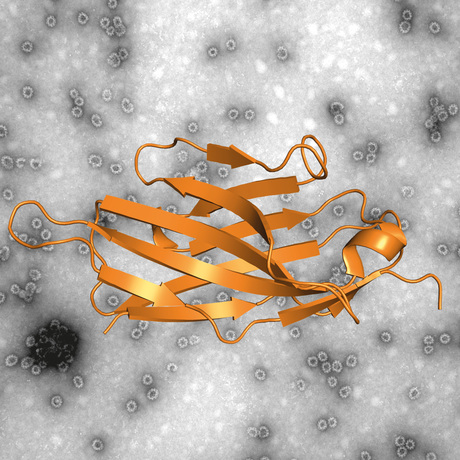Detecting and destroying norovirus

Norovirus, the most common cause of viral gastroenteritis in humans, is claimed to affect around 267 million people worldwide and cause over 200,000 deaths annually.
Depending on the surface and temperature conditions, the virus can survive for long periods outside a human host. It can still be viable after weeks on hard surfaces and up to 12 days on contaminated fabrics, and it can survive for months - maybe even years - in contaminated still water. A study done in 2006 found the virus still on several surfaces used for food preparation seven days after contamination.
Norovirus particles can cause illness even in relatively small numbers, estimated at perhaps as few as 10. The virus is transmitted by faeces-contaminated food or water, by person-to-person contact and via aerosolisation of the virus and subsequent contamination of surfaces.
Handling is the usual source of contamination for most foods. However, shellfish are most commonly contaminated by faeces-polluted water in the harvest area. Oysters, clams, mussels and cockles feed by filtering out particles in the water through their gills and diverting the particles to their mouths and digestive tracts. Bivalves can bio-concentrate viruses within their edible tissues to many times the levels in the surrounding water. This makes raw shellfish susceptible to high levels of norovirus contamination when the water is polluted.
Processing interventions that can be used to minimise the likelihood of norovirus contamination in molluscs can include washing all outer surfaces, pasteurisation or cooking, depuration, high-pressure processing and irradiation.
Now, a research team at the German Cancer Research Center (DKFZ) has produced ‘nanobodies’ that could be used to better characterise the structural makeup of the virus. They discovered that these nanobodies could detect the virus in clinical stool samples and disassemble intact norovirus particles. Such nanobodies may potentially be used to not only better detect but also treat symptoms of norovirus infection in the clinic.
Infection with highly contagious noroviruses, while not usually fatal, can lead to a slew of unpleasant symptoms such as excessive vomiting and diarrhoea. Current treatment options are limited to rehydration of the patient.
“Additionally, noroviruses come in a variety of constantly evolving strains. This makes the development of an effective vaccine to protect against infection, as well as antiviral therapy to combat already-existing infections, particularly challenging,” said Dr Grant Hansman, a virologist who leads the CHS Research Group on Noroviruses at DKFZ and Heidelberg University.
Hansman’s research team recently discovered that a nanobody called Nano-85 was able to bind to intact norovirus-like particles (VLPs) in culture. Nanobodies are very similar to antibodies, which recognise and bind to antigens. “However, nanobodies are much smaller, more stable, easier to produce and [more] cost-effective than traditional monoclonal antibodies,” said Hansman. Interestingly, Nano-85 was able to recognise the VLPs from a variety of different norovirus strains.
The researchers then tested the nanobody on stool samples from patients infected with the virus. In this context, Nano-85 was able to detect the virus in one third of the samples already known to be positive for noroviral RNA. “Because noroviruses are changing all the time, there is a need for more powerful tools to detect emerging noroviruses. We still need to optimise detection using Nano-85, but we hope that it could potentially be used as a diagnostic tool further on down the road,” explained Hansman.
In solution, Nano-85 was also able to bind to a specific portion of the VLP known as the protruding (P) domain. As with the VLPs, Nano-85 recognised the P domains from a variety of strains. Hansman describes the P domain as a structure that “essentially sticks out like a spike from the virus. Therefore, it has some degree of flexibility - like grass on a hill on a windy day. This ability to change shape likely allows the virus to evade recognition by the immune system - but could also make it more vulnerable to attack.”
Using X-ray crystallography, the researchers were able to determine the shape and molecular components of the Nano-85/P domain complex, as well as specific sites where Nano-85 and the P domain formed bonds. According to Hansman “this is, as far as we know, the first instance in which the molecular structure of a nanobody-P domain complex has been determined for norovirus”.
Interestingly, the investigators found that the site where Nano-85 bound to the P domain was actually hidden under the viral particle’s surface. “From the virus’s point of view, this could be a strategy to keep potentially vulnerable sites protected from attack,” explained Hansman. However, when they tried to create high-magnification images of the interaction using electron microscopy, they were surprised that they could not find any intact VLPs. This led them to believe that Nano-85 itself was actually causing the VLPs to break apart.
In describing the significance of these findings, Hansman said: “If Nano-85 is indeed causing intact VLPs to disassemble, this could be a very promising lead in developing norovirus antiviral therapy. This could be especially beneficial to immunosuppressed individuals such as cancer patients. Administering a vaccine to protect against infection would overwhelm the patient’s immune system. However, if he or she has the option of receiving an antiviral to eliminate the infection, the norovirus becomes much less dangerous.”
Functional ingredients feature in new product releases
From gut-friendly snacks for pets and humans to sugar-free drinks, functional ingredients are...
Wineries get smart with sensors to prevent overspill
When every drop of wine counts, innovative tech solutions are available to help wineries protect...
Making sweet and salted popcorn with no changeovers
A popcorn manufacturer wanted to achieve three things from its new line: pack small 11 g bags at...













